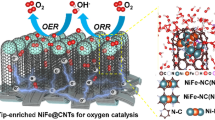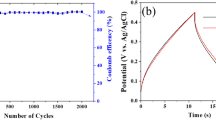Abstract
Orthorhombic niobium pentoxide (T-Nb2O5) possesses an intercalation pseudocapacitive behavior, which is a promising candidate of high-rate anodes for Li-ion capacitors. However, its low electric conductivity hinders the realization of this property. In our study, niobium oxides/carbon composites were prepared by calcinating a niobium peroxo-PAA complex (NbPAA) precursor to improve the electric conductivity. It has been found that the calcination temperature played an important role on the chemical compositions of obtained composites. A reduction phenomenon of niobium oxides by carbon was observed at high temperatures. At the medium temperature of 900 °C, the sample was composed of T-Nb2O5, monoclinic Nb2O5 (M-Nb2O5), amorphous carbon and niobium dioxide (NbO2). Due to the high conductivity of carbon, semi-conductivity of NbO2, and high specific capacity of M-Nb2O5, this sample exhibits a good specific capacity of 142 mAh g−1 (0.25 C) and a high-rate capability (capacity retention of 33.1%, 0.25 C to 25 C). It could be used as one of high-rate anodes for Li-ion capacitors.








Similar content being viewed by others
References
Li W, Song B, Manthiram A (2017) High-voltage positive electrode materials for lithium-ion batteries. Chem Soc Rev 46(10):3006–3059. https://doi.org/10.1039/C6CS00875E
Zuo W, Li R, Zhou C, Li Y, Xia J, Liu J (2017) Battery-supercapacitor hybrid devices: recent progress and future prospects. Adv Sci 4(7):1600539. https://doi.org/10.1002/advs.201600539
Dubal DP, Ayyad O, Ruiz V, Gómez-Romero P (2015) Hybrid energy storage: the merging of battery and supercapacitor chemistries. Chem Soc Rev 44(7):1777–1790. https://doi.org/10.1039/C4CS00266K
Li C, Zhang X, Sun C, Wang K, Sun X, Ma Y (2019) Recent progress of graphene-based materials in lithium-ion capacitors. J Phys D Appl Phys 52(14):143001. https://doi.org/10.1088/1361-6463/aaff3a
Choi HS, Park CR (2014) Theoretical guidelines to designing high performance energy storage device based on hybridization of lithium-ion battery and supercapacitor. J Power Sources 259:1–14. https://doi.org/10.1016/j.jpowsour.2014.02.001
Deng B, Lei T, Zhu W, Xiao L, Liu J (2018) In-plane assembled orthorhombic Nb2O5 nanorod films with high-rate Li+ intercalation for high-performance flexible Li-ion capacitors. Adv Funct Mater 28(1):1704330. https://doi.org/10.1002/adfm.201704330
Kong L, Zhang C, Wang J, Qiao W, Ling L, Long D (2015) Free-Standing T-Nb2O5/graphene composite papers with ultrahigh gravimetric/volumetric capacitance for Li-ion intercalation pseudocapacitor. ACS Nano 9(11):11200–11208. https://doi.org/10.1021/acsnano.5b04737
Naoi K, Naoi W, Aoyagi S, Miyamoto J-i, Kamino T (2013) New generation “nanohybrid supercapacitor.” Acc Chem Res 46(5):1075–1083. https://doi.org/10.1021/ar200308h
Augustyn V, Come J, Lowe MA, Kim JW, Taberna P-L, Tolbert SH, Abruña HD, Simon P, Dunn B (2013) High-rate electrochemical energy storage through Li+ intercalation pseudocapacitance. Nat Mater 12:518–522. https://doi.org/10.1038/nmat3601
Ma G, Li K, Li Y, Gao B, Ding T, Zhong Q, Su J, Gong L, Chen J, Yuan L, Hu B, Zhou J, Huo K (2016) High-performance hybrid supercapacitor based on graphene-wrapped mesoporous T-Nb2O5 nanospheres anode and mesoporous carbon-coated graphene cathode. ChemElectroChem 3(9):1360–1368. https://doi.org/10.1002/celc.201600181
Lim E, Jo C, Kim H, Kim M-H, Mun Y, Chun J, Ye Y, Hwang J, Ha K-S, Roh KC, Kang K, Yoon S, Lee J (2015) Facile synthesis of Nb2O5@carbon core–shell nanocrystals with controlled crystalline structure for high-power anodes in hybrid supercapacitors. ACS Nano 9(7):7497–7505. https://doi.org/10.1021/acsnano.5b02601
Yan L, Rui X, Chen G, Xu W, Zou G, Luo H (2016) Recent advances in nanostructured Nb-based oxides for electrochemical energy storage. Nanoscale 8(16):8443–8465. https://doi.org/10.1039/C6NR01340F
Kim JW, Augustyn V, Dunn B (2012) The effect of crystallinity on the rapid pseudocapacitive response of Nb2O5. Adv Energy Mater 2(1):141–148. https://doi.org/10.1002/aenm.201100494
Lim E, Kim H, Jo C, Chun J, Ku K, Kim S, Lee HI, Nam I-S, Yoon S, Kang K, Lee J (2014) Advanced hybrid supercapacitor based on a mesoporous niobium pentoxide/carbon as high-performance anode. ACS Nano 8(9):8968–8978. https://doi.org/10.1021/nn501972w
Yu H, Xu L, Wang H, Jiang H, Li C (2019) Nanochannel-confined synthesis of Nb2O5/CNTs nanopeapods for ultrastable lithium storage. Electrochim Acta 295:829–834. https://doi.org/10.1016/j.electacta.2018.11.017
Narendar Y, Messing GL (1997) Synthesis, decomposition and crystallization characteristics of peroxo−citrato−niobium: an aqueous niobium precursor. Chem Mater 9(2):580–587. https://doi.org/10.1021/cm960407w
Yerlikaya C, Ullah N, Kamali AR, Vasant Kumar R (2016) Size-controllable synthesis of lithium niobate nanocrystals using modified Pechini polymeric precursor method. J Therm Anal Calorim 125(1):17–22. https://doi.org/10.1007/s10973-016-5336-7
Kim JW, Augustyn V, Dunn B (2012) A road to environmentally friendly materials chemistry: low-temperature synthesis of nanosized K0.5Na0.5NbO3 powders through peroxide intermediates in water. Adv Energy Mater 2(1):141–148. https://doi.org/10.1002/aenm.201100494
Raba AM, Bautista-Ruíz J, Joya MR (2016) Synthesis and structural properties of niobium pentoxide powders: a comparative study of the growth process. Mater Res 19(6):1381–1387. https://doi.org/10.1590/1980-5373-mr-2015-0733
Sunde TOL, Grande T, Einarsrud M-A (2016) Modified Pechini synthesis of oxide powders and thin films. In: Klein L, Aparicio M, Jitianu A (eds) Handbook of sol-gel science and technology. Springer International Publishing, Cham, pp 1–30. https://doi.org/10.1007/978-3-319-19454-7_130-1
Lanfredi S, Folgueras-Domínguez S, Rodrigues ACM (1995) Preparation of LiNbO3 powder from the thermal decomposition of a precursor salt obtained by an evaporative method. J Mater Chem 5(11):1957–1961. https://doi.org/10.1039/JM9950501957
Cao J, Xiao G, Xu X, Shen D, Jin B (2013) Study on carbonization of lignin by TG-FTIR and high-temperature carbonization reactor. Fuel Process Technol 106:41–47. https://doi.org/10.1016/j.fuproc.2012.06.016
Ding H, Song Z, Zhang H, Zhang H, Li X (2020) Niobium-based oxide anodes toward fast and safe energy storage: a review. Mater Today Nano 11:100082. https://doi.org/10.1016/j.mtnano.2020.100082
Liao J, Tan R, Kuang Z, Cui C, Wei Z, Deng X, Yan Z, Feng Y, Li F, Wang C, Ma J (2018) Controlling the morphology, size and phase of Nb2O5 crystals for high electrochemical performance. Chin Chem Lett 29(12):1785–1790. https://doi.org/10.1016/j.cclet.2018.11.018
Park H, Lee D, Song T (2019) High capacity monoclinic Nb2O5 and semiconducting NbO2 composite as high-power anode material for Li-Ion batteries. J Power Sources 414:377–382. https://doi.org/10.1016/j.jpowsour.2019.01.015
Ramakrishnan S, Balamurugan J, Vinothkannan M, Kim AR, Sengodan S, Yoo DJ (2020) Nitrogen-doped graphene encapsulated FeCoMoS nanoparticles as advanced trifunctional catalyst for water splitting devices and zinc–air batteries. Appl Catal B Environ 279:119381. https://doi.org/10.1016/j.apcatb.2020.119381
Ramakrishnan S, Velusamy DB, Sengodan S, Nagaraju G, Kim DH, Kim AR, Yoo DJ (2022) Rational design of multifunctional electrocatalyst: An approach towards efficient overall water splitting and rechargeable flexible solid-state zinc–air battery. Appl Catal B Environ 300:120752. https://doi.org/10.1016/j.apcatb.2021.120752
Ramakrishnan S, Karuppannan M, Vinothkannan M, Ramachandran K, Kwon OJ, Yoo DJ (2019) Ultrafine Pt nanoparticles stabilized by MoS2/N-doped reduced graphene oxide as a durable electrocatalyst for alcohol oxidation and oxygen reduction reactions. ACS Appl Mater Interfaces 11(13):12504–12515. https://doi.org/10.1021/acsami.9b00192
Shim H, Lim E, Fleischmann S, Quade A, Tolosa A, Presser V (2019) Nanosized titanium niobium oxide/carbon electrodes for lithium-ion energy storage applications. Sustain Energy Fuels 3(7):1776–1789. https://doi.org/10.1039/C9SE00166B
Hu Z, He Q, Liu Z, Liu X, Qin M, Wen B, Shi W, Zhao Y, Li Q, Mai L (2020) Facile formation of tetragonal-Nb2O5 microspheres for high-rate and stable lithium storage with high areal capacity. Sci Bull 65(14):1154–1162. https://doi.org/10.1016/j.scib.2020.04.011
Asfaw HD, Tai C-W, Nyholm L, Edström K (2017) Over-stoichiometric NbO2 nanoparticles for a high energy and power density lithium microbattery. ChemNanoMat 3(9):646–655. https://doi.org/10.1002/cnma.201700141
Hou T, Tang G, Sun X, Cai S, Zheng C, Hu W (2017) Perchlorate ion doped polypyrrole coated ZnS sphere composites as a sodium-ion battery anode with superior rate capability enhanced by pseudocapacitance. RSC Adv 7(69):43636–43641. https://doi.org/10.1039/c7ra07901j
Boota M, Chen C, Van Aken KL, Jiang J, Gogotsi Y (2019) Organic-inorganic all-pseudocapacitive asymmetric energy storage devices. Nano Energy 65:104022. https://doi.org/10.1016/j.nanoen.2019.104022
Acknowledgements
This work is supported by the Ministry of Education, Youth, and Sports, Czech Republic INTER-EXCELLENCE program under the grant agreement No. LTT20005. It is also supported by the project RP/CPS/2020/005.
Author information
Authors and Affiliations
Corresponding author
Ethics declarations
Conflict of interest
The authors declare no competing or conflicts of interest.
Additional information
Handling Editor: M. Grant Norton.
Publisher's Note
Springer Nature remains neutral with regard to jurisdictional claims in published maps and institutional affiliations.
Rights and permissions
About this article
Cite this article
Fei, H., Kazantseva, N., Pechancova, V. et al. Effect of calcination temperature on electrochemical performance of niobium oxides/carbon composites. J Mater Sci 57, 8504–8515 (2022). https://doi.org/10.1007/s10853-022-06931-4
Received:
Accepted:
Published:
Issue Date:
DOI: https://doi.org/10.1007/s10853-022-06931-4




